Strategic Marketing 1: Marketing Orientation and Business Strategies
VerifiedAdded on 2021/10/26
|10
|2854
|101
Essay
AI Summary
This essay provides a comprehensive analysis of marketing orientation, emphasizing its pivotal role in business success. It defines marketing orientation as a customer-centric approach that identifies and addresses customer needs, contrasting it with other business orientations such as product, production, and sales orientations. The essay elucidates the interdependencies between these orientations, arguing that marketing orientation is paramount as it informs and guides the others. It details the importance of marketing orientation in fostering strong customer relationships, adapting to market demands, and achieving long-term profitability. Furthermore, the essay examines the key aspects of different business orientations including company, department, industry and human resource orientations. The essay concludes by highlighting factors that can hinder the effective implementation of marketing orientation, such as poor management, communication breakdowns, and lack of creativity, reinforcing the necessity of a holistic approach to strategic marketing. Overall, the essay underscores the supremacy of marketing orientation in driving business objectives and ensuring sustained competitive advantage.
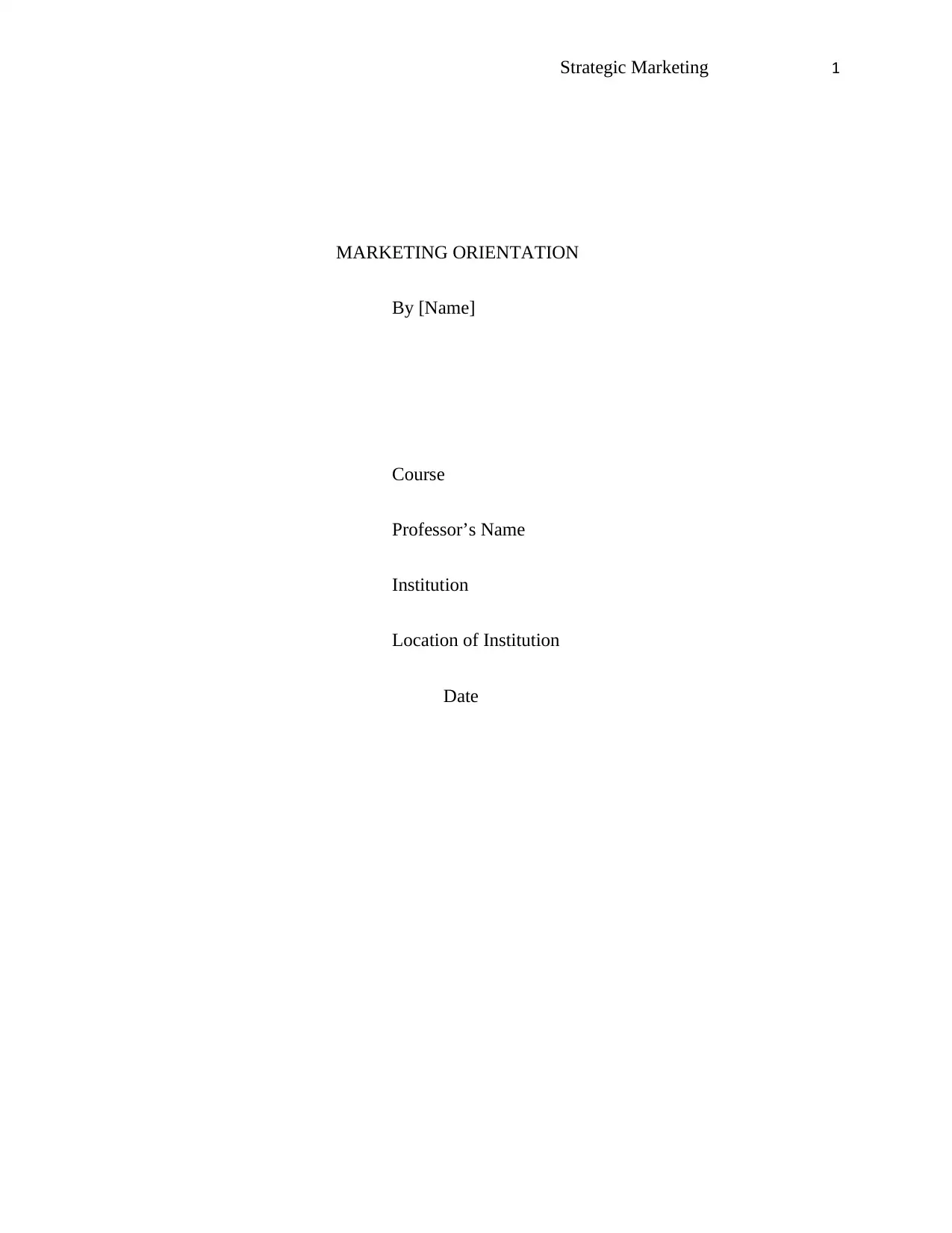
Strategic Marketing 1
MARKETING ORIENTATION
By [Name]
Course
Professor’s Name
Institution
Location of Institution
Date
MARKETING ORIENTATION
By [Name]
Course
Professor’s Name
Institution
Location of Institution
Date
Paraphrase This Document
Need a fresh take? Get an instant paraphrase of this document with our AI Paraphraser
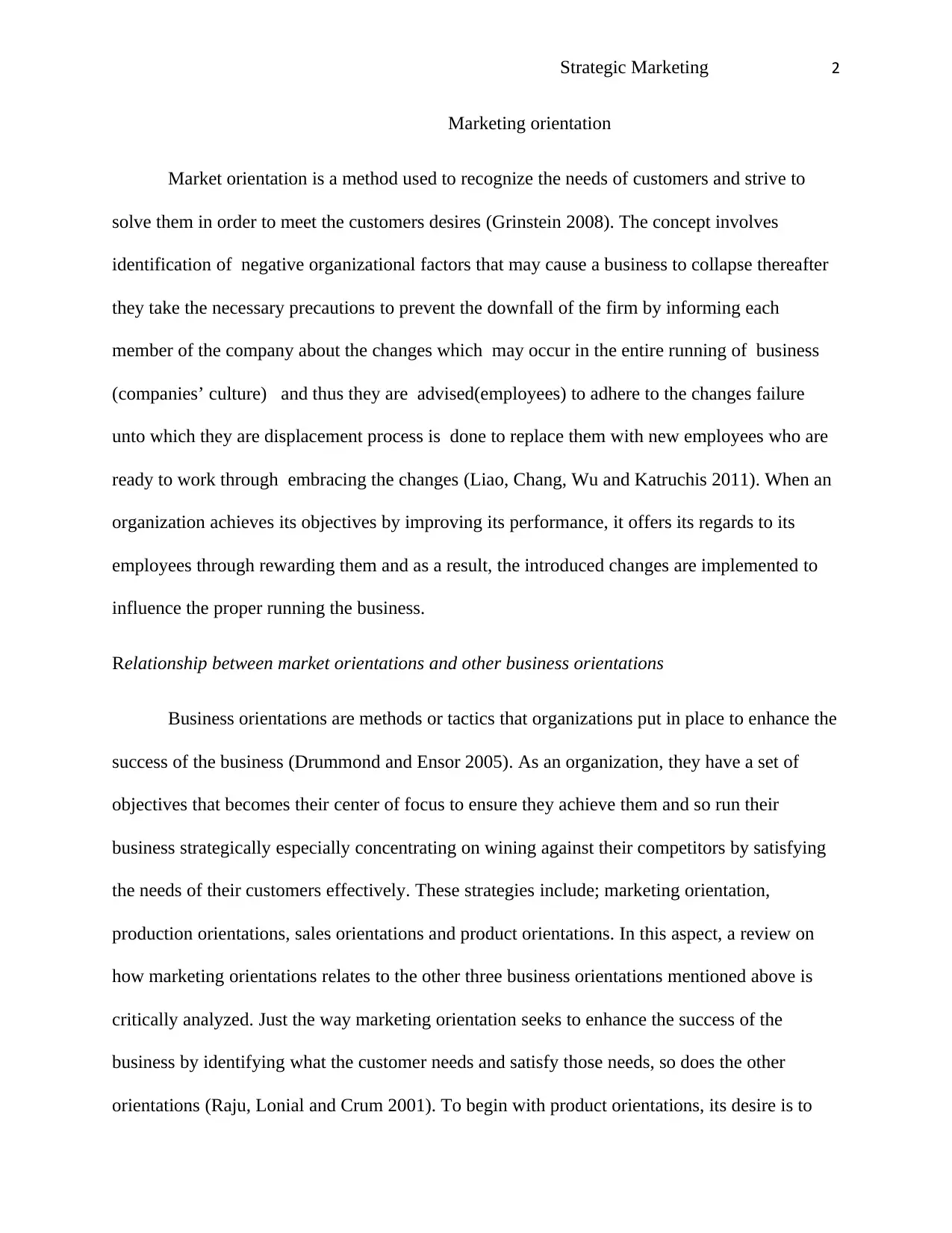
Strategic Marketing 2
Marketing orientation
Market orientation is a method used to recognize the needs of customers and strive to
solve them in order to meet the customers desires (Grinstein 2008). The concept involves
identification of negative organizational factors that may cause a business to collapse thereafter
they take the necessary precautions to prevent the downfall of the firm by informing each
member of the company about the changes which may occur in the entire running of business
(companies’ culture) and thus they are advised(employees) to adhere to the changes failure
unto which they are displacement process is done to replace them with new employees who are
ready to work through embracing the changes (Liao, Chang, Wu and Katruchis 2011). When an
organization achieves its objectives by improving its performance, it offers its regards to its
employees through rewarding them and as a result, the introduced changes are implemented to
influence the proper running the business.
Relationship between market orientations and other business orientations
Business orientations are methods or tactics that organizations put in place to enhance the
success of the business (Drummond and Ensor 2005). As an organization, they have a set of
objectives that becomes their center of focus to ensure they achieve them and so run their
business strategically especially concentrating on wining against their competitors by satisfying
the needs of their customers effectively. These strategies include; marketing orientation,
production orientations, sales orientations and product orientations. In this aspect, a review on
how marketing orientations relates to the other three business orientations mentioned above is
critically analyzed. Just the way marketing orientation seeks to enhance the success of the
business by identifying what the customer needs and satisfy those needs, so does the other
orientations (Raju, Lonial and Crum 2001). To begin with product orientations, its desire is to
Marketing orientation
Market orientation is a method used to recognize the needs of customers and strive to
solve them in order to meet the customers desires (Grinstein 2008). The concept involves
identification of negative organizational factors that may cause a business to collapse thereafter
they take the necessary precautions to prevent the downfall of the firm by informing each
member of the company about the changes which may occur in the entire running of business
(companies’ culture) and thus they are advised(employees) to adhere to the changes failure
unto which they are displacement process is done to replace them with new employees who are
ready to work through embracing the changes (Liao, Chang, Wu and Katruchis 2011). When an
organization achieves its objectives by improving its performance, it offers its regards to its
employees through rewarding them and as a result, the introduced changes are implemented to
influence the proper running the business.
Relationship between market orientations and other business orientations
Business orientations are methods or tactics that organizations put in place to enhance the
success of the business (Drummond and Ensor 2005). As an organization, they have a set of
objectives that becomes their center of focus to ensure they achieve them and so run their
business strategically especially concentrating on wining against their competitors by satisfying
the needs of their customers effectively. These strategies include; marketing orientation,
production orientations, sales orientations and product orientations. In this aspect, a review on
how marketing orientations relates to the other three business orientations mentioned above is
critically analyzed. Just the way marketing orientation seeks to enhance the success of the
business by identifying what the customer needs and satisfy those needs, so does the other
orientations (Raju, Lonial and Crum 2001). To begin with product orientations, its desire is to
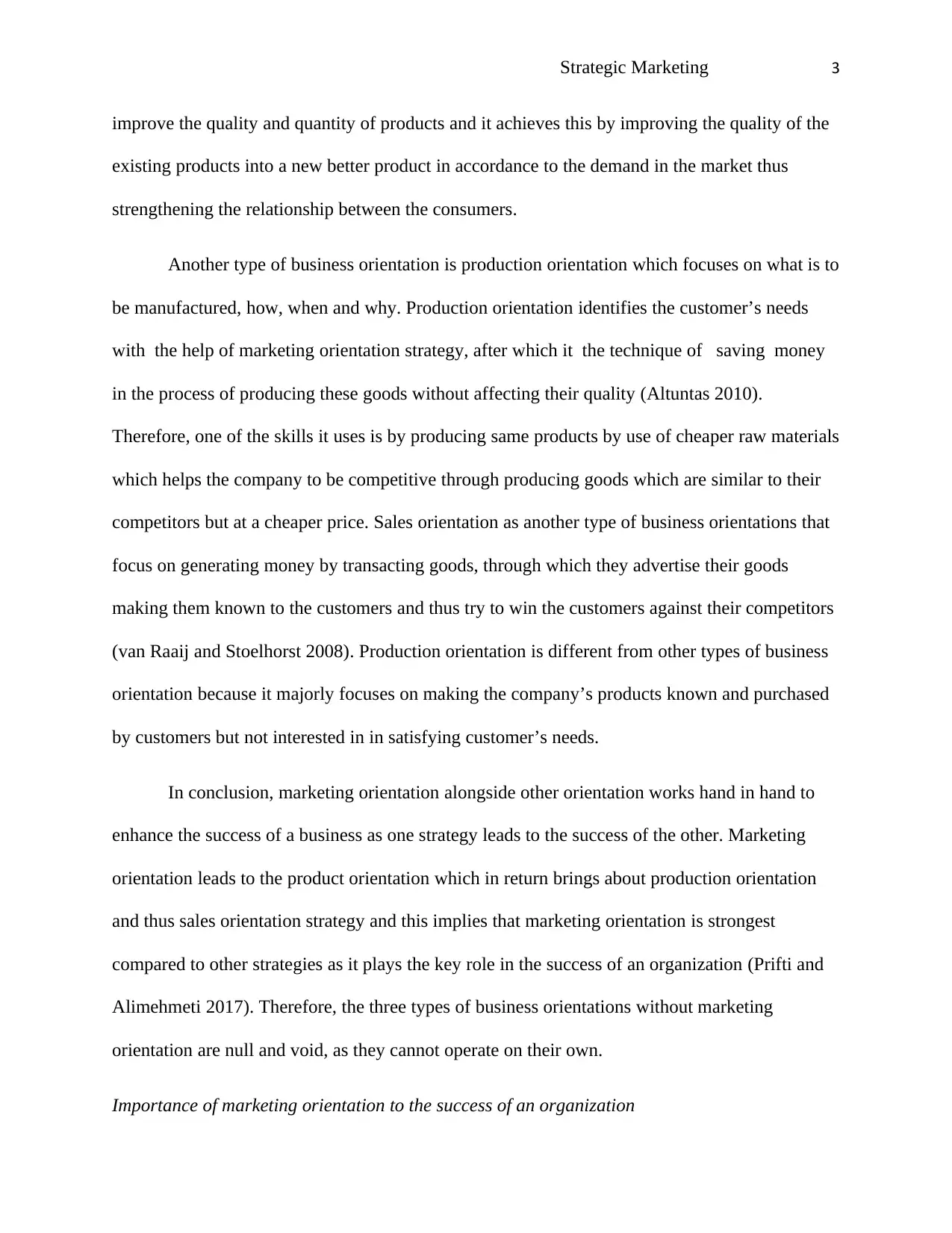
Strategic Marketing 3
improve the quality and quantity of products and it achieves this by improving the quality of the
existing products into a new better product in accordance to the demand in the market thus
strengthening the relationship between the consumers.
Another type of business orientation is production orientation which focuses on what is to
be manufactured, how, when and why. Production orientation identifies the customer’s needs
with the help of marketing orientation strategy, after which it the technique of saving money
in the process of producing these goods without affecting their quality (Altuntas 2010).
Therefore, one of the skills it uses is by producing same products by use of cheaper raw materials
which helps the company to be competitive through producing goods which are similar to their
competitors but at a cheaper price. Sales orientation as another type of business orientations that
focus on generating money by transacting goods, through which they advertise their goods
making them known to the customers and thus try to win the customers against their competitors
(van Raaij and Stoelhorst 2008). Production orientation is different from other types of business
orientation because it majorly focuses on making the company’s products known and purchased
by customers but not interested in in satisfying customer’s needs.
In conclusion, marketing orientation alongside other orientation works hand in hand to
enhance the success of a business as one strategy leads to the success of the other. Marketing
orientation leads to the product orientation which in return brings about production orientation
and thus sales orientation strategy and this implies that marketing orientation is strongest
compared to other strategies as it plays the key role in the success of an organization (Prifti and
Alimehmeti 2017). Therefore, the three types of business orientations without marketing
orientation are null and void, as they cannot operate on their own.
Importance of marketing orientation to the success of an organization
improve the quality and quantity of products and it achieves this by improving the quality of the
existing products into a new better product in accordance to the demand in the market thus
strengthening the relationship between the consumers.
Another type of business orientation is production orientation which focuses on what is to
be manufactured, how, when and why. Production orientation identifies the customer’s needs
with the help of marketing orientation strategy, after which it the technique of saving money
in the process of producing these goods without affecting their quality (Altuntas 2010).
Therefore, one of the skills it uses is by producing same products by use of cheaper raw materials
which helps the company to be competitive through producing goods which are similar to their
competitors but at a cheaper price. Sales orientation as another type of business orientations that
focus on generating money by transacting goods, through which they advertise their goods
making them known to the customers and thus try to win the customers against their competitors
(van Raaij and Stoelhorst 2008). Production orientation is different from other types of business
orientation because it majorly focuses on making the company’s products known and purchased
by customers but not interested in in satisfying customer’s needs.
In conclusion, marketing orientation alongside other orientation works hand in hand to
enhance the success of a business as one strategy leads to the success of the other. Marketing
orientation leads to the product orientation which in return brings about production orientation
and thus sales orientation strategy and this implies that marketing orientation is strongest
compared to other strategies as it plays the key role in the success of an organization (Prifti and
Alimehmeti 2017). Therefore, the three types of business orientations without marketing
orientation are null and void, as they cannot operate on their own.
Importance of marketing orientation to the success of an organization
⊘ This is a preview!⊘
Do you want full access?
Subscribe today to unlock all pages.

Trusted by 1+ million students worldwide
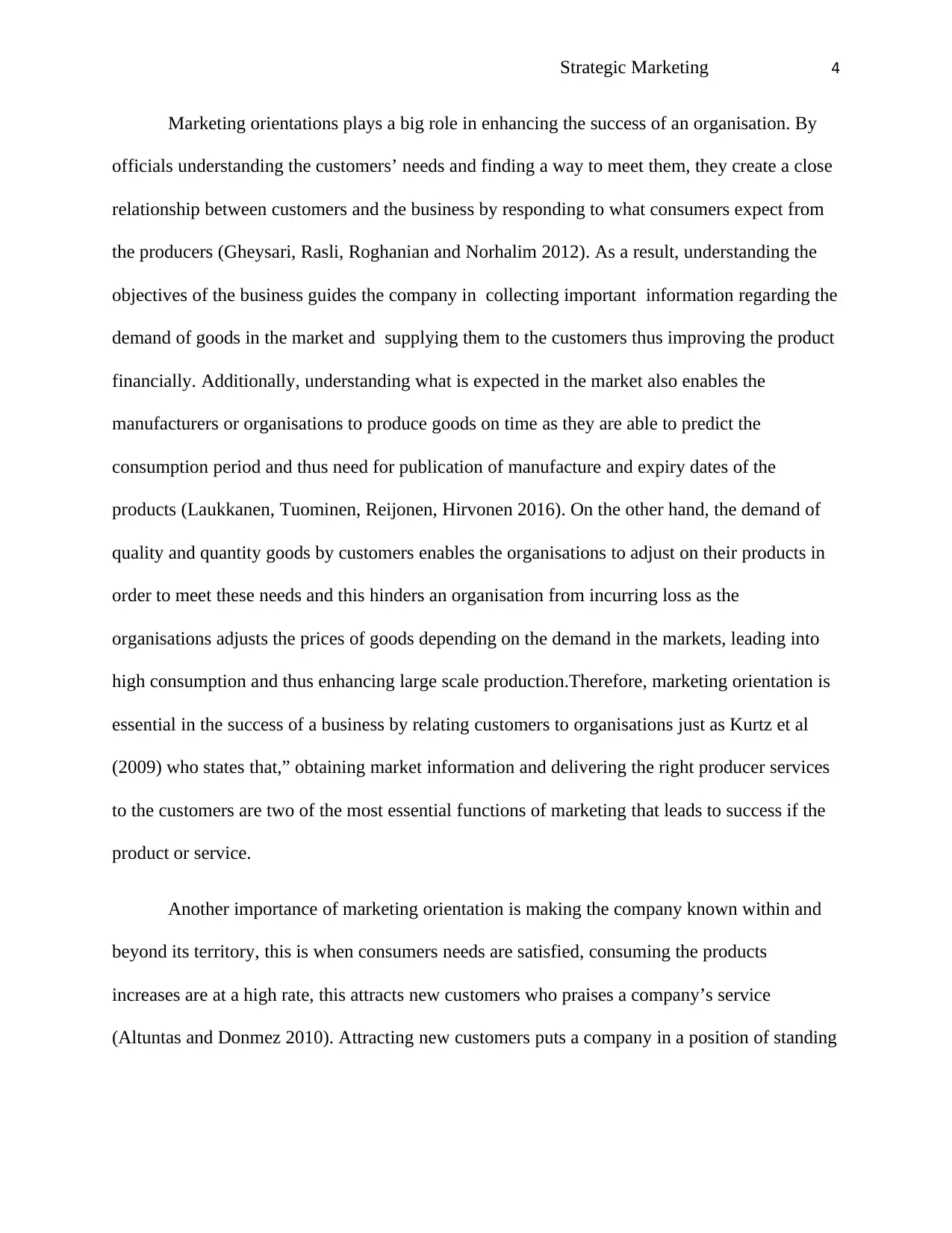
Strategic Marketing 4
Marketing orientations plays a big role in enhancing the success of an organisation. By
officials understanding the customers’ needs and finding a way to meet them, they create a close
relationship between customers and the business by responding to what consumers expect from
the producers (Gheysari, Rasli, Roghanian and Norhalim 2012). As a result, understanding the
objectives of the business guides the company in collecting important information regarding the
demand of goods in the market and supplying them to the customers thus improving the product
financially. Additionally, understanding what is expected in the market also enables the
manufacturers or organisations to produce goods on time as they are able to predict the
consumption period and thus need for publication of manufacture and expiry dates of the
products (Laukkanen, Tuominen, Reijonen, Hirvonen 2016). On the other hand, the demand of
quality and quantity goods by customers enables the organisations to adjust on their products in
order to meet these needs and this hinders an organisation from incurring loss as the
organisations adjusts the prices of goods depending on the demand in the markets, leading into
high consumption and thus enhancing large scale production.Therefore, marketing orientation is
essential in the success of a business by relating customers to organisations just as Kurtz et al
(2009) who states that,” obtaining market information and delivering the right producer services
to the customers are two of the most essential functions of marketing that leads to success if the
product or service.
Another importance of marketing orientation is making the company known within and
beyond its territory, this is when consumers needs are satisfied, consuming the products
increases are at a high rate, this attracts new customers who praises a company’s service
(Altuntas and Donmez 2010). Attracting new customers puts a company in a position of standing
Marketing orientations plays a big role in enhancing the success of an organisation. By
officials understanding the customers’ needs and finding a way to meet them, they create a close
relationship between customers and the business by responding to what consumers expect from
the producers (Gheysari, Rasli, Roghanian and Norhalim 2012). As a result, understanding the
objectives of the business guides the company in collecting important information regarding the
demand of goods in the market and supplying them to the customers thus improving the product
financially. Additionally, understanding what is expected in the market also enables the
manufacturers or organisations to produce goods on time as they are able to predict the
consumption period and thus need for publication of manufacture and expiry dates of the
products (Laukkanen, Tuominen, Reijonen, Hirvonen 2016). On the other hand, the demand of
quality and quantity goods by customers enables the organisations to adjust on their products in
order to meet these needs and this hinders an organisation from incurring loss as the
organisations adjusts the prices of goods depending on the demand in the markets, leading into
high consumption and thus enhancing large scale production.Therefore, marketing orientation is
essential in the success of a business by relating customers to organisations just as Kurtz et al
(2009) who states that,” obtaining market information and delivering the right producer services
to the customers are two of the most essential functions of marketing that leads to success if the
product or service.
Another importance of marketing orientation is making the company known within and
beyond its territory, this is when consumers needs are satisfied, consuming the products
increases are at a high rate, this attracts new customers who praises a company’s service
(Altuntas and Donmez 2010). Attracting new customers puts a company in a position of standing
Paraphrase This Document
Need a fresh take? Get an instant paraphrase of this document with our AI Paraphraser
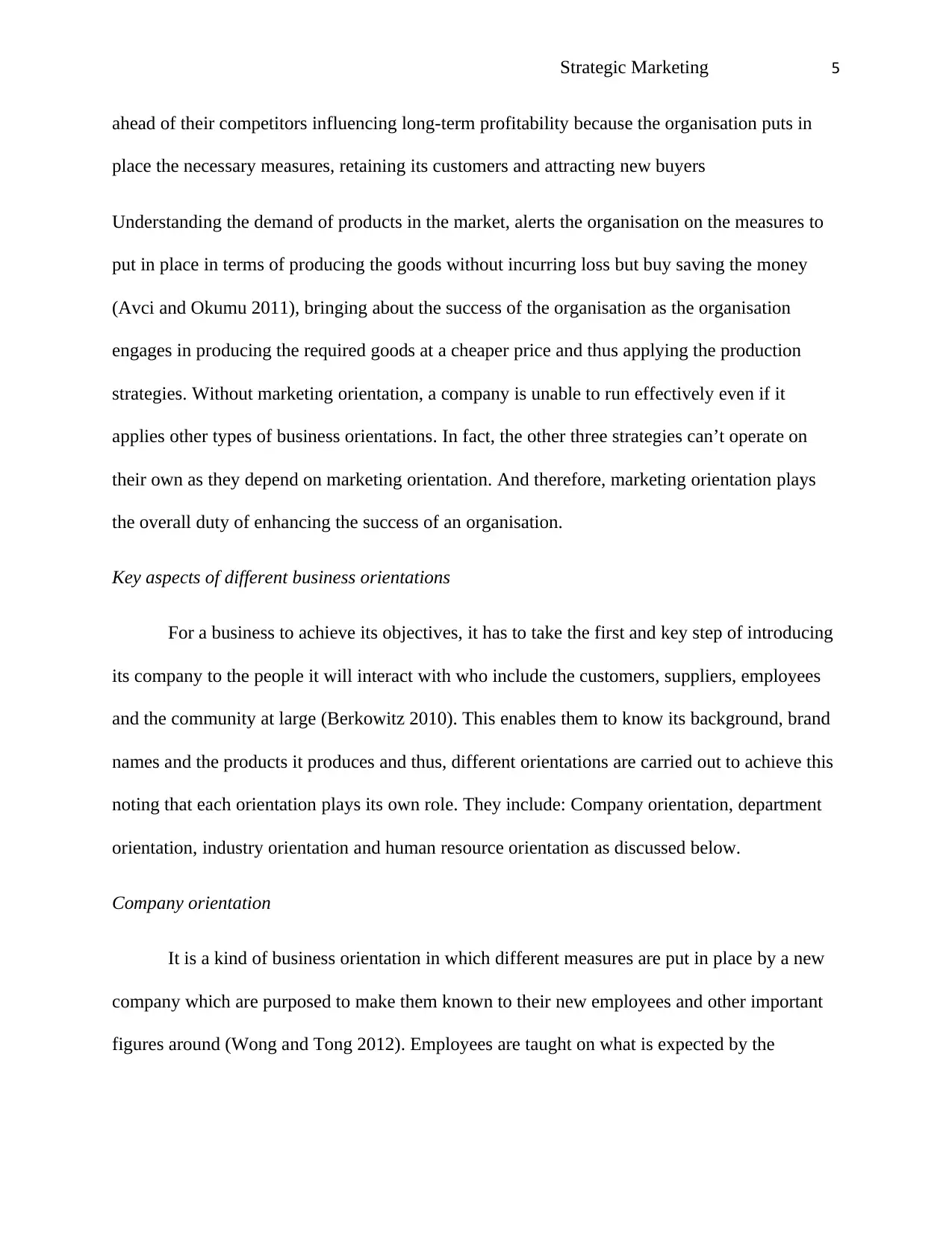
Strategic Marketing 5
ahead of their competitors influencing long-term profitability because the organisation puts in
place the necessary measures, retaining its customers and attracting new buyers
Understanding the demand of products in the market, alerts the organisation on the measures to
put in place in terms of producing the goods without incurring loss but buy saving the money
(Avci and Okumu 2011), bringing about the success of the organisation as the organisation
engages in producing the required goods at a cheaper price and thus applying the production
strategies. Without marketing orientation, a company is unable to run effectively even if it
applies other types of business orientations. In fact, the other three strategies can’t operate on
their own as they depend on marketing orientation. And therefore, marketing orientation plays
the overall duty of enhancing the success of an organisation.
Key aspects of different business orientations
For a business to achieve its objectives, it has to take the first and key step of introducing
its company to the people it will interact with who include the customers, suppliers, employees
and the community at large (Berkowitz 2010). This enables them to know its background, brand
names and the products it produces and thus, different orientations are carried out to achieve this
noting that each orientation plays its own role. They include: Company orientation, department
orientation, industry orientation and human resource orientation as discussed below.
Company orientation
It is a kind of business orientation in which different measures are put in place by a new
company which are purposed to make them known to their new employees and other important
figures around (Wong and Tong 2012). Employees are taught on what is expected by the
ahead of their competitors influencing long-term profitability because the organisation puts in
place the necessary measures, retaining its customers and attracting new buyers
Understanding the demand of products in the market, alerts the organisation on the measures to
put in place in terms of producing the goods without incurring loss but buy saving the money
(Avci and Okumu 2011), bringing about the success of the organisation as the organisation
engages in producing the required goods at a cheaper price and thus applying the production
strategies. Without marketing orientation, a company is unable to run effectively even if it
applies other types of business orientations. In fact, the other three strategies can’t operate on
their own as they depend on marketing orientation. And therefore, marketing orientation plays
the overall duty of enhancing the success of an organisation.
Key aspects of different business orientations
For a business to achieve its objectives, it has to take the first and key step of introducing
its company to the people it will interact with who include the customers, suppliers, employees
and the community at large (Berkowitz 2010). This enables them to know its background, brand
names and the products it produces and thus, different orientations are carried out to achieve this
noting that each orientation plays its own role. They include: Company orientation, department
orientation, industry orientation and human resource orientation as discussed below.
Company orientation
It is a kind of business orientation in which different measures are put in place by a new
company which are purposed to make them known to their new employees and other important
figures around (Wong and Tong 2012). Employees are taught on what is expected by the
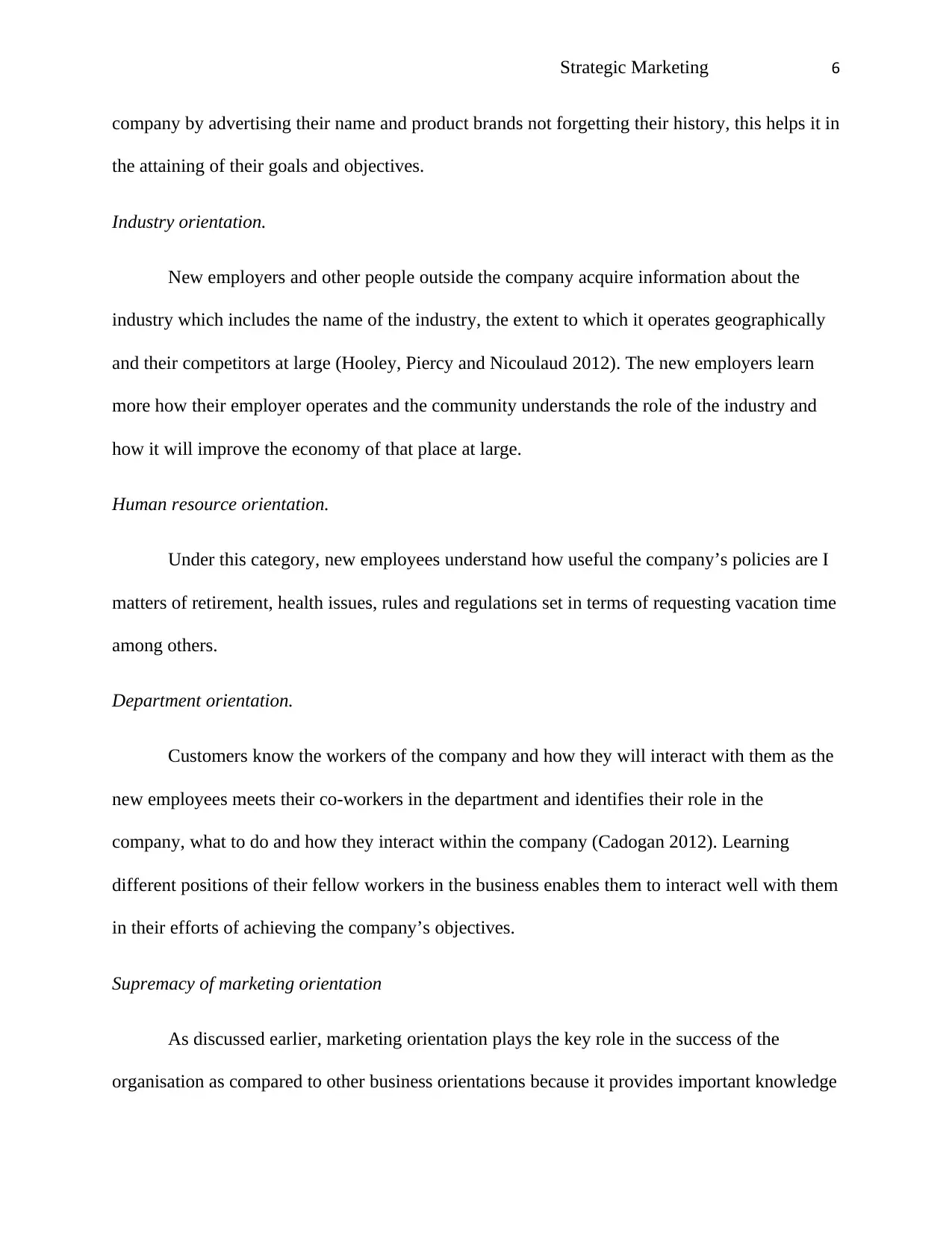
Strategic Marketing 6
company by advertising their name and product brands not forgetting their history, this helps it in
the attaining of their goals and objectives.
Industry orientation.
New employers and other people outside the company acquire information about the
industry which includes the name of the industry, the extent to which it operates geographically
and their competitors at large (Hooley, Piercy and Nicoulaud 2012). The new employers learn
more how their employer operates and the community understands the role of the industry and
how it will improve the economy of that place at large.
Human resource orientation.
Under this category, new employees understand how useful the company’s policies are I
matters of retirement, health issues, rules and regulations set in terms of requesting vacation time
among others.
Department orientation.
Customers know the workers of the company and how they will interact with them as the
new employees meets their co-workers in the department and identifies their role in the
company, what to do and how they interact within the company (Cadogan 2012). Learning
different positions of their fellow workers in the business enables them to interact well with them
in their efforts of achieving the company’s objectives.
Supremacy of marketing orientation
As discussed earlier, marketing orientation plays the key role in the success of the
organisation as compared to other business orientations because it provides important knowledge
company by advertising their name and product brands not forgetting their history, this helps it in
the attaining of their goals and objectives.
Industry orientation.
New employers and other people outside the company acquire information about the
industry which includes the name of the industry, the extent to which it operates geographically
and their competitors at large (Hooley, Piercy and Nicoulaud 2012). The new employers learn
more how their employer operates and the community understands the role of the industry and
how it will improve the economy of that place at large.
Human resource orientation.
Under this category, new employees understand how useful the company’s policies are I
matters of retirement, health issues, rules and regulations set in terms of requesting vacation time
among others.
Department orientation.
Customers know the workers of the company and how they will interact with them as the
new employees meets their co-workers in the department and identifies their role in the
company, what to do and how they interact within the company (Cadogan 2012). Learning
different positions of their fellow workers in the business enables them to interact well with them
in their efforts of achieving the company’s objectives.
Supremacy of marketing orientation
As discussed earlier, marketing orientation plays the key role in the success of the
organisation as compared to other business orientations because it provides important knowledge
⊘ This is a preview!⊘
Do you want full access?
Subscribe today to unlock all pages.

Trusted by 1+ million students worldwide
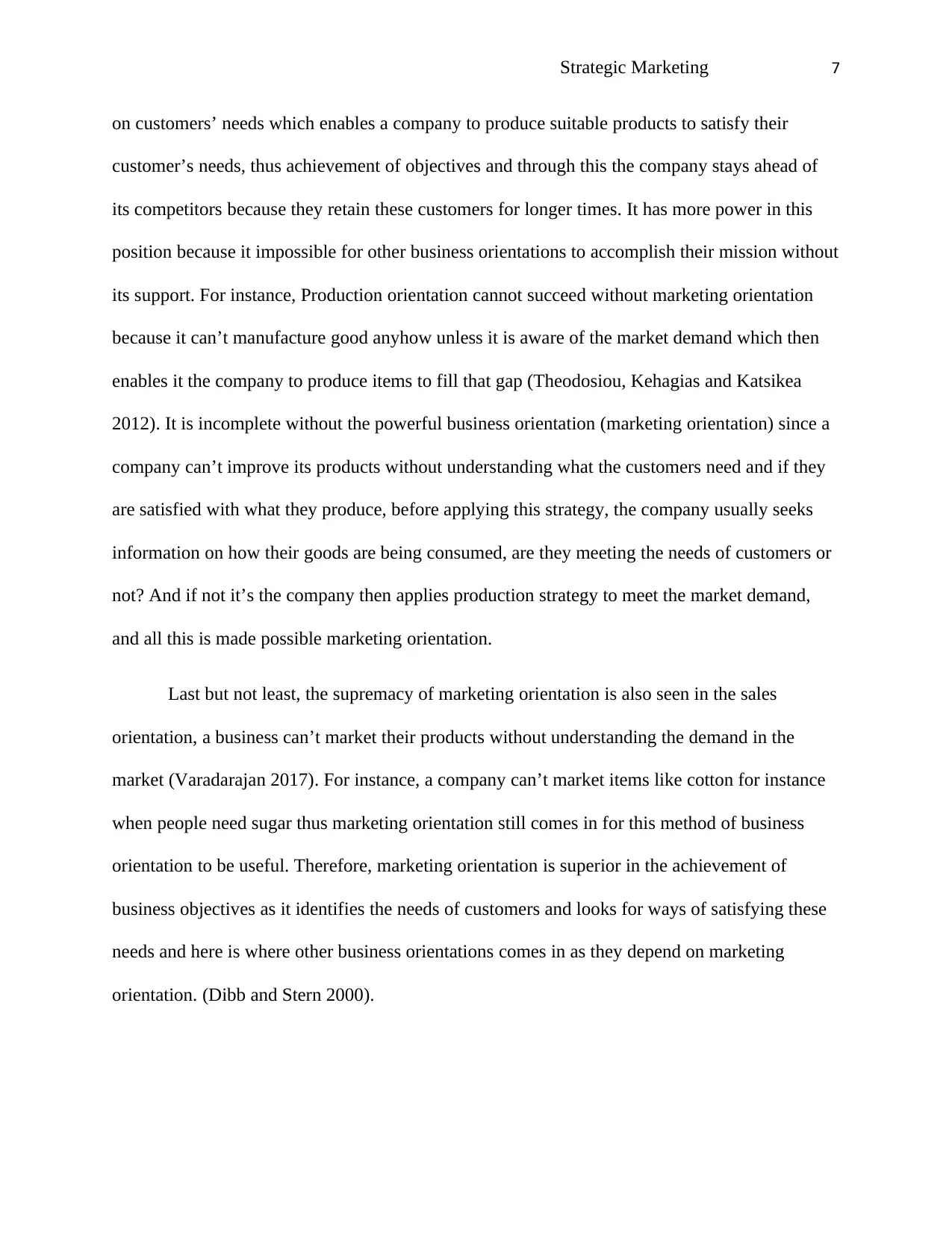
Strategic Marketing 7
on customers’ needs which enables a company to produce suitable products to satisfy their
customer’s needs, thus achievement of objectives and through this the company stays ahead of
its competitors because they retain these customers for longer times. It has more power in this
position because it impossible for other business orientations to accomplish their mission without
its support. For instance, Production orientation cannot succeed without marketing orientation
because it can’t manufacture good anyhow unless it is aware of the market demand which then
enables it the company to produce items to fill that gap (Theodosiou, Kehagias and Katsikea
2012). It is incomplete without the powerful business orientation (marketing orientation) since a
company can’t improve its products without understanding what the customers need and if they
are satisfied with what they produce, before applying this strategy, the company usually seeks
information on how their goods are being consumed, are they meeting the needs of customers or
not? And if not it’s the company then applies production strategy to meet the market demand,
and all this is made possible marketing orientation.
Last but not least, the supremacy of marketing orientation is also seen in the sales
orientation, a business can’t market their products without understanding the demand in the
market (Varadarajan 2017). For instance, a company can’t market items like cotton for instance
when people need sugar thus marketing orientation still comes in for this method of business
orientation to be useful. Therefore, marketing orientation is superior in the achievement of
business objectives as it identifies the needs of customers and looks for ways of satisfying these
needs and here is where other business orientations comes in as they depend on marketing
orientation. (Dibb and Stern 2000).
on customers’ needs which enables a company to produce suitable products to satisfy their
customer’s needs, thus achievement of objectives and through this the company stays ahead of
its competitors because they retain these customers for longer times. It has more power in this
position because it impossible for other business orientations to accomplish their mission without
its support. For instance, Production orientation cannot succeed without marketing orientation
because it can’t manufacture good anyhow unless it is aware of the market demand which then
enables it the company to produce items to fill that gap (Theodosiou, Kehagias and Katsikea
2012). It is incomplete without the powerful business orientation (marketing orientation) since a
company can’t improve its products without understanding what the customers need and if they
are satisfied with what they produce, before applying this strategy, the company usually seeks
information on how their goods are being consumed, are they meeting the needs of customers or
not? And if not it’s the company then applies production strategy to meet the market demand,
and all this is made possible marketing orientation.
Last but not least, the supremacy of marketing orientation is also seen in the sales
orientation, a business can’t market their products without understanding the demand in the
market (Varadarajan 2017). For instance, a company can’t market items like cotton for instance
when people need sugar thus marketing orientation still comes in for this method of business
orientation to be useful. Therefore, marketing orientation is superior in the achievement of
business objectives as it identifies the needs of customers and looks for ways of satisfying these
needs and here is where other business orientations comes in as they depend on marketing
orientation. (Dibb and Stern 2000).
Paraphrase This Document
Need a fresh take? Get an instant paraphrase of this document with our AI Paraphraser
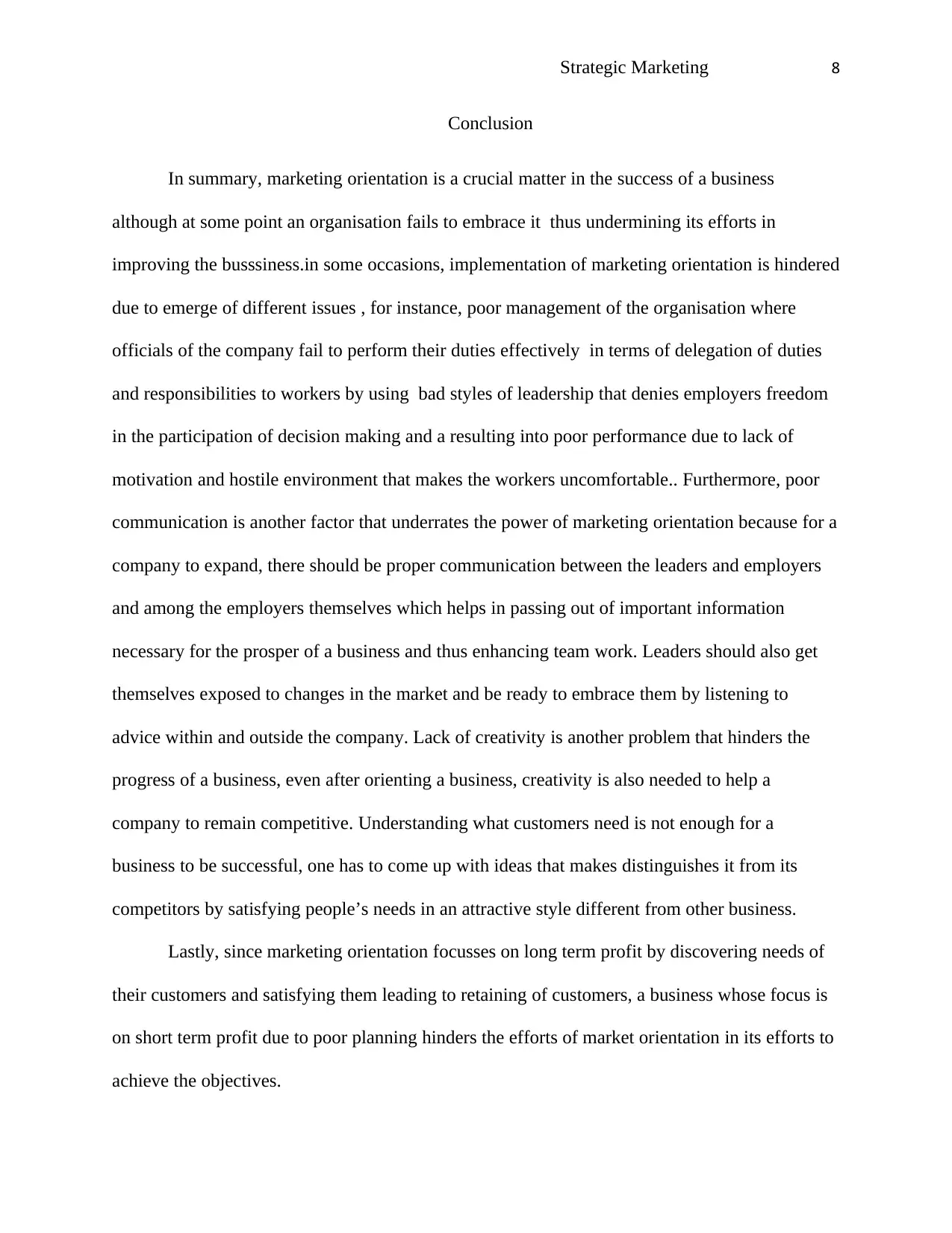
Strategic Marketing 8
Conclusion
In summary, marketing orientation is a crucial matter in the success of a business
although at some point an organisation fails to embrace it thus undermining its efforts in
improving the busssiness.in some occasions, implementation of marketing orientation is hindered
due to emerge of different issues , for instance, poor management of the organisation where
officials of the company fail to perform their duties effectively in terms of delegation of duties
and responsibilities to workers by using bad styles of leadership that denies employers freedom
in the participation of decision making and a resulting into poor performance due to lack of
motivation and hostile environment that makes the workers uncomfortable.. Furthermore, poor
communication is another factor that underrates the power of marketing orientation because for a
company to expand, there should be proper communication between the leaders and employers
and among the employers themselves which helps in passing out of important information
necessary for the prosper of a business and thus enhancing team work. Leaders should also get
themselves exposed to changes in the market and be ready to embrace them by listening to
advice within and outside the company. Lack of creativity is another problem that hinders the
progress of a business, even after orienting a business, creativity is also needed to help a
company to remain competitive. Understanding what customers need is not enough for a
business to be successful, one has to come up with ideas that makes distinguishes it from its
competitors by satisfying people’s needs in an attractive style different from other business.
Lastly, since marketing orientation focusses on long term profit by discovering needs of
their customers and satisfying them leading to retaining of customers, a business whose focus is
on short term profit due to poor planning hinders the efforts of market orientation in its efforts to
achieve the objectives.
Conclusion
In summary, marketing orientation is a crucial matter in the success of a business
although at some point an organisation fails to embrace it thus undermining its efforts in
improving the busssiness.in some occasions, implementation of marketing orientation is hindered
due to emerge of different issues , for instance, poor management of the organisation where
officials of the company fail to perform their duties effectively in terms of delegation of duties
and responsibilities to workers by using bad styles of leadership that denies employers freedom
in the participation of decision making and a resulting into poor performance due to lack of
motivation and hostile environment that makes the workers uncomfortable.. Furthermore, poor
communication is another factor that underrates the power of marketing orientation because for a
company to expand, there should be proper communication between the leaders and employers
and among the employers themselves which helps in passing out of important information
necessary for the prosper of a business and thus enhancing team work. Leaders should also get
themselves exposed to changes in the market and be ready to embrace them by listening to
advice within and outside the company. Lack of creativity is another problem that hinders the
progress of a business, even after orienting a business, creativity is also needed to help a
company to remain competitive. Understanding what customers need is not enough for a
business to be successful, one has to come up with ideas that makes distinguishes it from its
competitors by satisfying people’s needs in an attractive style different from other business.
Lastly, since marketing orientation focusses on long term profit by discovering needs of
their customers and satisfying them leading to retaining of customers, a business whose focus is
on short term profit due to poor planning hinders the efforts of market orientation in its efforts to
achieve the objectives.
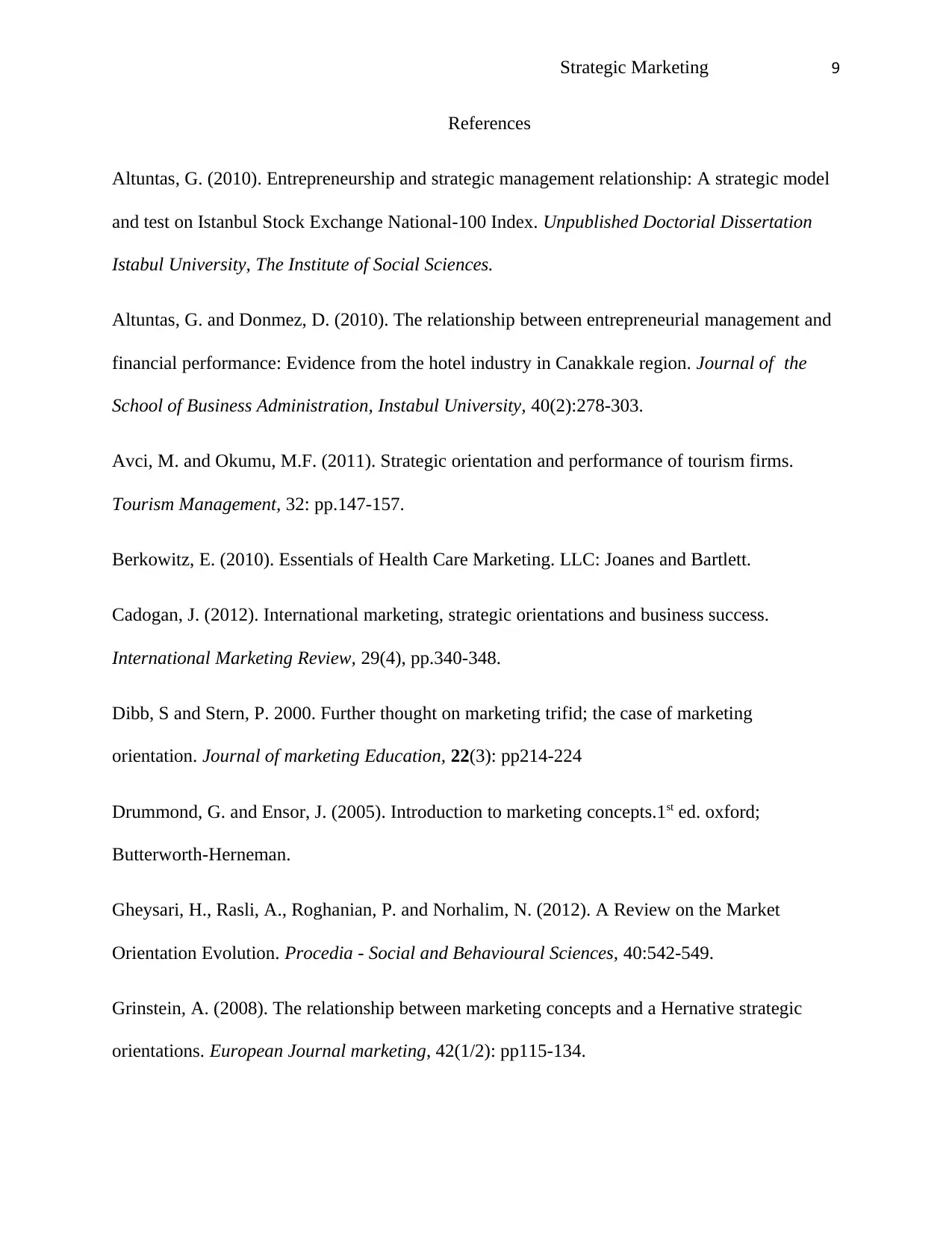
Strategic Marketing 9
References
Altuntas, G. (2010). Entrepreneurship and strategic management relationship: A strategic model
and test on Istanbul Stock Exchange National-100 Index. Unpublished Doctorial Dissertation
Istabul University, The Institute of Social Sciences.
Altuntas, G. and Donmez, D. (2010). The relationship between entrepreneurial management and
financial performance: Evidence from the hotel industry in Canakkale region. Journal of the
School of Business Administration, Instabul University, 40(2):278-303.
Avci, M. and Okumu, M.F. (2011). Strategic orientation and performance of tourism firms.
Tourism Management, 32: pp.147-157.
Berkowitz, E. (2010). Essentials of Health Care Marketing. LLC: Joanes and Bartlett.
Cadogan, J. (2012). International marketing, strategic orientations and business success.
International Marketing Review, 29(4), pp.340-348.
Dibb, S and Stern, P. 2000. Further thought on marketing trifid; the case of marketing
orientation. Journal of marketing Education, 22(3): pp214-224
Drummond, G. and Ensor, J. (2005). Introduction to marketing concepts.1st ed. oxford;
Butterworth-Herneman.
Gheysari, H., Rasli, A., Roghanian, P. and Norhalim, N. (2012). A Review on the Market
Orientation Evolution. Procedia - Social and Behavioural Sciences, 40:542-549.
Grinstein, A. (2008). The relationship between marketing concepts and a Hernative strategic
orientations. European Journal marketing, 42(1/2): pp115-134.
References
Altuntas, G. (2010). Entrepreneurship and strategic management relationship: A strategic model
and test on Istanbul Stock Exchange National-100 Index. Unpublished Doctorial Dissertation
Istabul University, The Institute of Social Sciences.
Altuntas, G. and Donmez, D. (2010). The relationship between entrepreneurial management and
financial performance: Evidence from the hotel industry in Canakkale region. Journal of the
School of Business Administration, Instabul University, 40(2):278-303.
Avci, M. and Okumu, M.F. (2011). Strategic orientation and performance of tourism firms.
Tourism Management, 32: pp.147-157.
Berkowitz, E. (2010). Essentials of Health Care Marketing. LLC: Joanes and Bartlett.
Cadogan, J. (2012). International marketing, strategic orientations and business success.
International Marketing Review, 29(4), pp.340-348.
Dibb, S and Stern, P. 2000. Further thought on marketing trifid; the case of marketing
orientation. Journal of marketing Education, 22(3): pp214-224
Drummond, G. and Ensor, J. (2005). Introduction to marketing concepts.1st ed. oxford;
Butterworth-Herneman.
Gheysari, H., Rasli, A., Roghanian, P. and Norhalim, N. (2012). A Review on the Market
Orientation Evolution. Procedia - Social and Behavioural Sciences, 40:542-549.
Grinstein, A. (2008). The relationship between marketing concepts and a Hernative strategic
orientations. European Journal marketing, 42(1/2): pp115-134.
⊘ This is a preview!⊘
Do you want full access?
Subscribe today to unlock all pages.

Trusted by 1+ million students worldwide
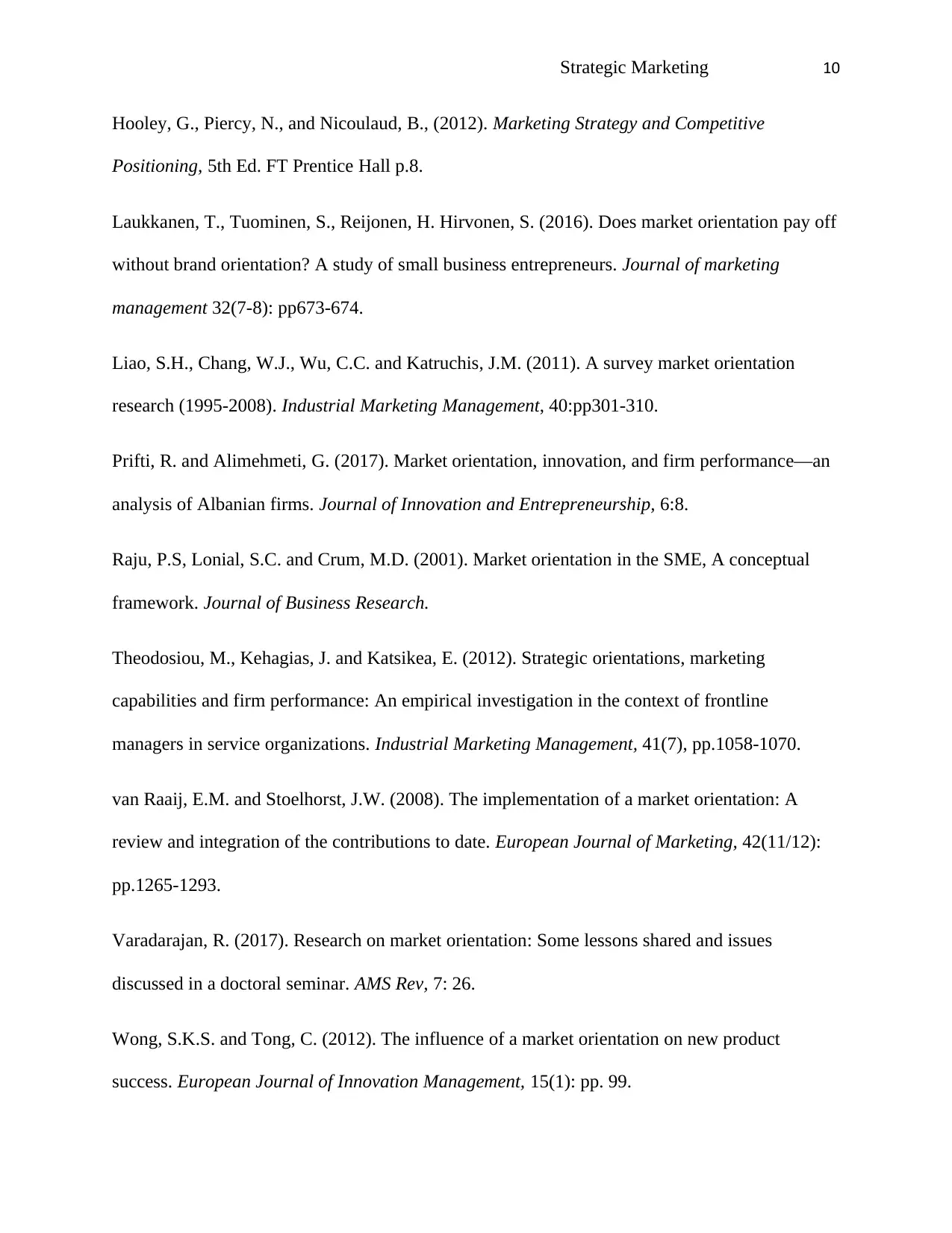
Strategic Marketing 10
Hooley, G., Piercy, N., and Nicoulaud, B., (2012). Marketing Strategy and Competitive
Positioning, 5th Ed. FT Prentice Hall p.8.
Laukkanen, T., Tuominen, S., Reijonen, H. Hirvonen, S. (2016). Does market orientation pay off
without brand orientation? A study of small business entrepreneurs. Journal of marketing
management 32(7-8): pp673-674.
Liao, S.H., Chang, W.J., Wu, C.C. and Katruchis, J.M. (2011). A survey market orientation
research (1995-2008). Industrial Marketing Management, 40:pp301-310.
Prifti, R. and Alimehmeti, G. (2017). Market orientation, innovation, and firm performance—an
analysis of Albanian firms. Journal of Innovation and Entrepreneurship, 6:8.
Raju, P.S, Lonial, S.C. and Crum, M.D. (2001). Market orientation in the SME, A conceptual
framework. Journal of Business Research.
Theodosiou, M., Kehagias, J. and Katsikea, E. (2012). Strategic orientations, marketing
capabilities and firm performance: An empirical investigation in the context of frontline
managers in service organizations. Industrial Marketing Management, 41(7), pp.1058-1070.
van Raaij, E.M. and Stoelhorst, J.W. (2008). The implementation of a market orientation: A
review and integration of the contributions to date. European Journal of Marketing, 42(11/12):
pp.1265-1293.
Varadarajan, R. (2017). Research on market orientation: Some lessons shared and issues
discussed in a doctoral seminar. AMS Rev, 7: 26.
Wong, S.K.S. and Tong, C. (2012). The influence of a market orientation on new product
success. European Journal of Innovation Management, 15(1): pp. 99.
Hooley, G., Piercy, N., and Nicoulaud, B., (2012). Marketing Strategy and Competitive
Positioning, 5th Ed. FT Prentice Hall p.8.
Laukkanen, T., Tuominen, S., Reijonen, H. Hirvonen, S. (2016). Does market orientation pay off
without brand orientation? A study of small business entrepreneurs. Journal of marketing
management 32(7-8): pp673-674.
Liao, S.H., Chang, W.J., Wu, C.C. and Katruchis, J.M. (2011). A survey market orientation
research (1995-2008). Industrial Marketing Management, 40:pp301-310.
Prifti, R. and Alimehmeti, G. (2017). Market orientation, innovation, and firm performance—an
analysis of Albanian firms. Journal of Innovation and Entrepreneurship, 6:8.
Raju, P.S, Lonial, S.C. and Crum, M.D. (2001). Market orientation in the SME, A conceptual
framework. Journal of Business Research.
Theodosiou, M., Kehagias, J. and Katsikea, E. (2012). Strategic orientations, marketing
capabilities and firm performance: An empirical investigation in the context of frontline
managers in service organizations. Industrial Marketing Management, 41(7), pp.1058-1070.
van Raaij, E.M. and Stoelhorst, J.W. (2008). The implementation of a market orientation: A
review and integration of the contributions to date. European Journal of Marketing, 42(11/12):
pp.1265-1293.
Varadarajan, R. (2017). Research on market orientation: Some lessons shared and issues
discussed in a doctoral seminar. AMS Rev, 7: 26.
Wong, S.K.S. and Tong, C. (2012). The influence of a market orientation on new product
success. European Journal of Innovation Management, 15(1): pp. 99.
1 out of 10
Related Documents
Your All-in-One AI-Powered Toolkit for Academic Success.
+13062052269
info@desklib.com
Available 24*7 on WhatsApp / Email
![[object Object]](/_next/static/media/star-bottom.7253800d.svg)
Unlock your academic potential
Copyright © 2020–2025 A2Z Services. All Rights Reserved. Developed and managed by ZUCOL.




